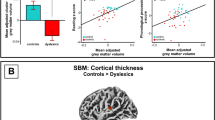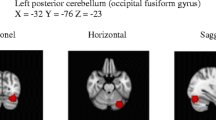Abstract
Although some form of central nervous system involvement is presumed, evidence establishing a relationship between dyslexia and neurological dysfunction has been correlational. Recently, neuroimaging and postmortem studies have begun to provide direct evidence implicating neuropathological structures in dyslexia. This article reviews computed tomography (CT) and magnetic resonance imaging (MRI) studies examining deviations in brain morphology which appear to be associated with neurolinguistic functioning. Methodological and technical issues are discussed. Based on their own and others research, the authors conclude that dyslexics show variations in specific brain regions, namely, reversed or symmetrical plana temporale (L≤R), smaller insular length bilaterally, and symmetrical frontal regions. Moreover, recent studies by the senior author and colleagues suggest that specific reading tasks are associated with specific variations in brain morphology. Symmetrical frontal widths was related to poorer passage comprehension, and reversed frontal area symmetry was related to poor word attack skills. Though many conceptual and technical issues remain unresolved, neuroimaging procedures appear to provide direct evidence supporting the importance of deviations in normal patterns of brain morphology in dyslexia.
Similar content being viewed by others
References
Campbell S., and Whitaker H. (1986). Cortical maturation and developmental neurolinguistics. In J. E. Obrzut and G. W. Hynd (eds.), Child Neuropsychology: Theory and Research Vol. 1, pp. 55–72. New York: Academic Press.
Chui H. C., and Damasio A. R. (1980). Human cerebral asymmetries evaluated by computerized tomography. Journal of Neurology, Neurosurgery, and Psychiatry, 43, 873–878.
Corballis M. C., and Beale I. C. (1976). The Psychology of Left and Right. Hillsdale, NJ: Erlbaum.
Coren S., Porac C., and Duncan P. (1979). A behaviorally validated self-report inventory to assess four types of lateral preference. Journal of Clinical Neuropsychology, 1, 33–64.
Denckla M. B., LeMay M., and Chapman C. A. (1985). Few CT scan abnormalities found even in neurologically impaired learning disabled children. Journal of Learning Disabilities, 18, 132–135.
Eidelberg D., and Galabruda A. M. (1982). Symmetry and asymmetry in the human posterior thalamus: I Cytoarchitectonic analysis in normal persons. Archives of Neurology, 39, 325–332.
Evans W. A. (1942). An encephalographic ratio for estimating ventricular enlargement and cerebral atrophy. Archives of Neurology, 47, 931–937.
Falzi G., Perrone P., and Vignolo L. A. (1982). Right-left asymmetry in anterior speech region. Archives of Neurology, 39, 239–240.
Filipek P. A., Kennedy D. N., Caviness V. S., Rossnick S. L., Spraggins T. A., Starewicz P. M. (1989). Magnetic resonance imaging-based brain morphology: Development and application to normal subjects. Annals of Neurology, 25, 61–67.
Fleschig P. (1908). Zentrablatt Neurologie-Psychiatrie, 27, 50.
Galaburda A. M., and Kemper T. L. (1979). Cytoarchitectonic abnormalities in developmental dyslexia: a case study. Annals of Neurology, 6, 94–100.
Galaburda A., and Sanides F. (1980). Cytoarchitectonic organization of the human auditory cortex. Journal of Comparative Neurology, 190, 597–610.
Galaburda A. M., Sherman G. F., Rosen G. D., Aboitiz F., Geschwind N. (1985). Developmental dyslexia: Four consecutive patients with cortical abnormalities. Annuals of Neurology, 18, 222–233.
Galaburda A. M., Corsiglia J., Rosen G. D., and Serman G. F. (1987). Planum temporale asymmetry, reappraisal since Geschwind and Levitsky. Neuropsychologia, 25, 853–868.
Geschwind N. (1974). The development of the brain and the evolution of language. In N. Geschwind (eds.), Selected Papers on Language and the Brain. Dordrecht, The Netherlands: D. Reidel.
Geschwind N. (1984). Cerebral dominance in biological perspective. Neuropsychologia, 22, 675–683.
Geschwind N., and Behan P. O. (1982). Left handedness: Association with immune disease, migraine, and developmental learning disorders. proceedings of the National Academy of Sciences, 79, 5097–5100.
Geschwind N., and Galaburda A. M. (1985a). Cerebral lateralization: Biological mechanisms, associations, and pathology: I. A hypothesis and a program for research. Archives of Neurology, 42, 428–459.
Geschwind N., and Galaburda A. M. (1985b). Cerebral lateralization: Biological mechanisms, associations, and pathology: II. A hypothesis and a program for research. Archives of Neurology, 42, 521–552.
Geschwind N., and Galaburda A. M. (1985c). Cerebral lateralization: Biological mechanisms, associations, and pathology: III. A hypothesis and a program for research. Archives of Neurology, 42, 634–654.
Geschwind N., and Levitsky W. (1968). Human brain: Left-right asymmetries in temporal speech region. Science, 161, 186–187.
Golden G. S. (1982). Neurobiological correlates of learning disabilities. Annals of Neurology, 12, 409–418.
Gross-Glenn K., Duara R., Yoshii F., Baker W. W., Chang J. Y., Apicella A., Boothe T., and Lubs H. A. (1986). PET-scan studies during reading in dyslexic and nondyslexic adults [abstract], Neuroscience, 24, 371.
Hardyck C., Petrinovitch L. F., and Goldman R. (1976). Left handedness and cognitive deficit. Cortex, 12, 266–278.
Harris T. L., and Hodges R. E. (eds.). (1981). A Dictionary of Reading and Related Terms. Newark, NJ: International Reading Association.
Haslam R. H., Dalby J. T., Johns R. D., and Rademaker A. W. (1981). Cerebral asymmetry in developmental dyslexia. Archives of Neurology, 38, 679–682.
Hier D. B., LeMay M., Rosenberger P. B., and Perlo V. P. (1978). Developmental dyslexia: Evidence for a subgroup with a reversal of cerebral asymmetry. Archives of Neurology, 35, 90–92.
Hynd G. W., and Semrud-Clikeman M. (1989a). Dyslexia and neurodevelopmental pathology: Relationships to cognition, intelligence and reading skill acquisition. Journal of Learning Disabilities, 22, 204–216.
Hynd G. W., and Semrud-Clikeman M. (1989b). Dyslexia and brain morphology. Psychological Bulletin, 106, 447–482.
Hynd G. W., Semrud-Clikeman M., Lorys A. R., Novey E. S., and Eliopulos D. (1990). Brain morphology in developmental dyslexia and attention deficit disorder/hyperactivity. Archives of Neurology, 47, 919–926.
Kinsbourne M., and Hiscock M. (1981). Cerebral lateralization and cognitive development: Conceptual and methodological issues. In G. W. Hynd and J. E. Obrzut (eds.), Neuropsychological Assessment and the School-Age Child: Issues and Procedures (pp. 125–166). New York: Grune and Stratton.
Kopp N., Michel F., Carrier H., Biron A., and Duvillard P. (1977). Etude de certaines asymetries hemispheriques du cerveau humain. Journal of the Neurological Sciences, 34, 349–363.
Kuperman S., Gaffney G. R., Hamden-Allen G., Preston D. F., and Venkatesh L. (1990). Neuroimaging in child and adolescent psychiatry. Journal of the American Academy of Child and Adolescent Psychiatry, 29, 159–172.
Larsen J. P., Høien T., Lundberg I., and Odegaard H. (1990). MRI evaluation of the size and symmetry of the planum temporale in adolescents with developmental dyslexia. Brain and Language, 39, 289–301.
Leisman G., and Ashkenazi M. (1980). Aetiological factors in dyslexia: IV. Cerebral hemispheres are functionally equivalent. Neuroscience, 11, 157–164.
LeMay M. (1976). Morphological cerebral asymmetries of modern man, fossil man, and nonhuman primates. Annals of the New York Academy of Science, 280, 349–366.
LeMay M. (1981). Are there radiological changes in the brains of individuals with dyslexia? Bulletin of the Orton Society, 31, 135–141.
Lingam S., Read S., Holland I. M., Wilson J., Brett E. M., and Hoare R. D. (1982). Value of computerized tomography in children with non-specific mental subnormality. Archives of Disease in Childhood, 57, 381–383.
Lou H. C., Henriksen L. and Bruhn P. (1984). Focal cerebral hypoperfusion in children with dysphasia and/or attention deficit disorder. Archives of Neurology, 41, 852–829.
Lou H. C., Henriksen L., and Bruhn P. (1989). Striatal dysfunction in attention deficit and hyperkinetic disorder. Archives of Neurology, 46, 48–52.
Moeschler J. B., Bennett F. C. and Cromwell L. P. (1981). Use of the CT scan in the medical evaluation of the mentally retarded child. The Journal of Pediatrics, 98, 63–65.
Morris R., Blashfield R., and Satz P. (1986). Developmental classfication of readingdisabled children. Journal of Clinical and Experimental Neuropsychology, 8, 371–392.
Naeser M. A. and Hayward R. W. (1978). Lesion localization in aphasia with cranial computed tomography and the Boston Diagnostic Aphasia Examination, Neurology, 28, 545–551.
Parkins, R., Roberts, R. J., Reinarz, S. J. and Varney, N. R. (1987, January). CT asymmetries in adult developmental dyslexics. Paper presented at the annual convention of the International Neuropsychological Society, Washington, DC.
Pieniadz J. M. and Naeser M. A. (1984). Computed tomographic scan cerebral asymmetries and morphological brain asymmetries. Archives of Neurology, 41, 403–409.
Pieniadz J. M., Naeser M. A., Koff E., and Levine H. L. (1983). CT scan cerebral hemispheric asymmetry measurements in stroke cases with global aphasia: Atypical asymmetries associated with improved recovery. Cortex, 19, 371–391.
Rosenberger P. B. and Hier D. B. (1980). Cerebral asymmetry and verbal intellectual deficits. Annals of Neurology, 8, 300–304.
Rubens A. B., Mahuwold M. W., and Hutton J. T. (1976). Asymmetry of the lateral (sylvian) fissures in man. Neurology, 26, 620–624.
Rumsey J. M., Dorwart R., Vermess M., Denckla M. B., Kruesi M. J. P., and Rapoport J. L. (1986). Magnetic resonance imaging of brain anatomy in severe developmental dyslexia. Arhives of Neurology, 43, 1045–1046.
Semrud-Clikeman, M., Hynd, G. W., Novey, E. S., and Eliopulos, D. (in press). Dyslexia and brain morphology: Relationships between neuroanatomical variation and neurolinguistic tasks. Learning and Individual Differences.
Steinmetz H., Ebeling U., Huang Y. and Kahn T. (1990). Sulcus topography of the parietal opercular region: An anatomic and MR study. Brain and Language, 38, 515–533.
Synek V., Reuben J. R., and Duboulay G. H. (1976). Comparing Evan's index and computerized axial tomography in assessing relationships of ventricular size to brain size. Neurology, 26, 231–233.
Taylor H. G., Fletcher J. M. (1983). Biological foundations of “specific developmental disorders”: Methods, findings, and future directions. Journal of Clinical Child Psychology, 12, 46–65.
Teszner D., Tzavaras A., Gruner J., and Hecaen H. (1972). L'asymetri droite-gauche du planum temporale: A propos de l'etude anatomique de 100 cerveaux. Revue Neurologique, 126, 444–449.
Von Economo C., and Horn L. (1930). Zeitschrift fur die gesamte Neurologie und Psyuchiatrie, 130, 678.
Wada J. A., Clarke R., and Hamm A. (1975). Cerebral hemispheric asymmetry in humans. Archives of Neurology, 32, 239–246.
Weinberger D. R., Luchins D. J., Morihisa J., and Wyatt R. J. (1982). Asymmetrical volumes of the right and left frontal and occipital regions of the human brain. Neurology, 11, 97–100.
Witelson S. F. (1982). Bumps on the brain: Right-left anatomic asymmetry as a key to functional laterialization. In S. Segalowitz (eds.), Language Functions and Brain Organization (pp. 117–144). New York: Academic Press.
Witelson S. F. and Pallie W. (1973). Left hemisphere specialization for language in the newborn. Brain, 96, 641–646.
Author information
Authors and Affiliations
Rights and permissions
About this article
Cite this article
Hynd, G.W., Marshall, R.M. & Semrud-Clikeman, M. Developmental dyslexia, neurolinguistic theory and deviations in brain morphology. Reading and Writing: An Interdisciplinary Journal 3, 345–362 (1991). https://doi.org/10.1007/BF00354967
Issue Date:
DOI: https://doi.org/10.1007/BF00354967




